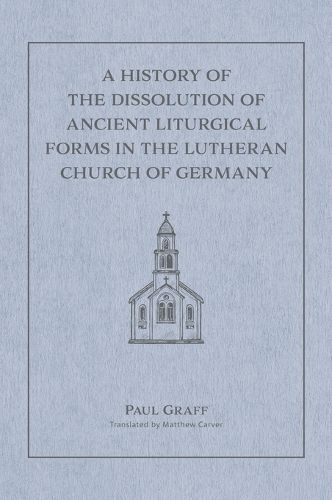Readings Newsletter
Become a Readings Member to make your shopping experience even easier.
Sign in or sign up for free!
You’re not far away from qualifying for FREE standard shipping within Australia
You’ve qualified for FREE standard shipping within Australia
The cart is loading…






Geschichte der Aufloesung der alten gottesdienstlichen Formen in der evangelischen Kirche Deutschlands (informally, "Graff") is a German academic work from the 1920-30s (two vols. with a second edition) that surveys and explains German liturgical life from the Reformation to the end of the Enlightenment (approximately 1517-1800).
A librarian at the Lutheran Loccum Abbey, Paul Graff used the old Lutheran church orders and agendas as the basis of his detailed account. He discusses the various periods generally with respect to prevailing attitudes and circumstances, then provides detailed examples of specific liturgical services and rites from a wide swath of German-speaking territories. Each volume also includes an appendix on musical movements in and associated with German evangelical liturgical life. Finally, copious footnotes and indexes on names and topics, Scripture verses, hymns, and works cited provide exhaustive means for further research. These volumes represent perhaps the most ready compilation of references to Lutheran worship documents and scholarship prior to World War II, as well as discussions of Lutheran architecture, church furnishings, and liturgical attire.
Music and history scholars, along with pastors and church professionals, will appreciate having this source document available in English.
$9.00 standard shipping within Australia
FREE standard shipping within Australia for orders over $100.00
Express & International shipping calculated at checkout
Geschichte der Aufloesung der alten gottesdienstlichen Formen in der evangelischen Kirche Deutschlands (informally, "Graff") is a German academic work from the 1920-30s (two vols. with a second edition) that surveys and explains German liturgical life from the Reformation to the end of the Enlightenment (approximately 1517-1800).
A librarian at the Lutheran Loccum Abbey, Paul Graff used the old Lutheran church orders and agendas as the basis of his detailed account. He discusses the various periods generally with respect to prevailing attitudes and circumstances, then provides detailed examples of specific liturgical services and rites from a wide swath of German-speaking territories. Each volume also includes an appendix on musical movements in and associated with German evangelical liturgical life. Finally, copious footnotes and indexes on names and topics, Scripture verses, hymns, and works cited provide exhaustive means for further research. These volumes represent perhaps the most ready compilation of references to Lutheran worship documents and scholarship prior to World War II, as well as discussions of Lutheran architecture, church furnishings, and liturgical attire.
Music and history scholars, along with pastors and church professionals, will appreciate having this source document available in English.